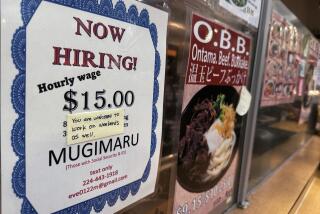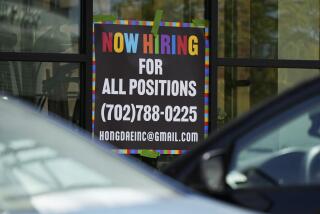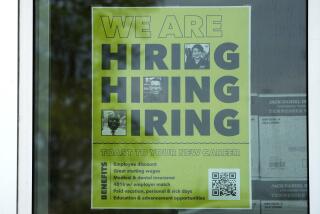Jobless aid applications stay low, a sign of few layoffs
The number of Americans seeking unemployment benefits was little changed last week, evidence that employers are cutting few jobs.
Weekly applications for jobless aid ticked up 1,000 to a seasonally adjusted 295,000, the Labor Department said Thursday. The four-week average, a less volatile measure, increased to 284,500. Still, that is just 2,000 higher than three weeks ago when the average was at a nearly 15-year low.
Applications are a proxy for layoffs. The very low level of the average is a sign of solid job security.
Growth slowed in the first three months of the year and hiring weakened in March. Yet when applications are low, it suggests employers aren’t worried enough to cut jobs. That, in turn, could be a sign the growth slowdown will be temporary.
More Americans are receiving benefits: The number of recipients rose 50,000 to 2.33 million in the week ending April 11, the latest data available. Yet that increase comes after the total fell to a 14-year low in the previous week.
Businesses cut back on hiring in March amid signs that harsh winter weather and cautious consumers weighed on the economy.
Employers added just 126,000 jobs during the month, the fewest in 15 months and snapping a yearlong streak of monthly gains above 200,000. The unemployment rate remained 5.5 percent.
The stronger dollar is also slowing growth. It has made U.S. exports more expensive, cutting into sales and dragging down factory production. Lower oil prices have also caused oil and gas drillers to order less steel pipe and other drilling equipment.
Many Americans, meanwhile, are saving the windfall from lower prices at the pump or using it to pay down debt. Consumer spending, a key driver of the economy, was likely much slower in the first quarter than many economists forecast.
Analysts now expect that the economy grew at a 1 percent annual rate or less in the first three months of this year. That’s down sharply from about 3.6 percent in the second half of last year.
More to Read
Inside the business of entertainment
The Wide Shot brings you news, analysis and insights on everything from streaming wars to production — and what it all means for the future.
You may occasionally receive promotional content from the Los Angeles Times.










